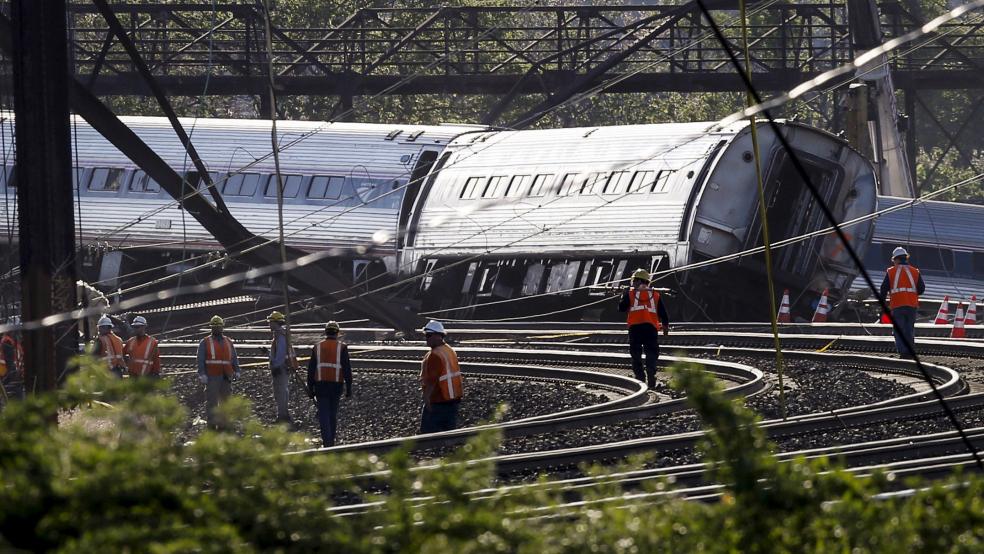The death toll from Tuesday’s tragic Amtrak derailment in Philadelphia now stands at seven, with more than 200 others injured. The train reportedly jumped the tracks after traveling at more than 100 miles an hour, or twice the speed limit for that stretch, making the Amtrak tragedy just the latest in a line of high-profile mass transit tragedies that potentially could have been avoided.
Some numbers on train safety might help put the catastrophe in context. The total number of train-related deaths had fallen from 2006 to 2012, but has been rising since then, reaching 813 last year, according to data from the Federal Railroad Administration’s Office of Safety Analysis. The first two months of this year saw 133 rail-related deaths, putting 2015 well ahead of last year’s pace even before the latest Amtrak incident. “The reality is that nearly every 180 minutes in America, someone is hit by a train,” the Federal Railroad Administration website says. Yikes.

But — and this is a big but — the total for 2014 includes 509 people killed while trespassing on tracks and another 270 who were killed in so-called “highway-rail grade crossing incidents,” meaning at sites where train tracks cross with highways, streets and sidewalks. Similarly, the total for January and February of this year includes 73 trespassing deaths and 42 people killed in highway-rail incidents. “Combined, highway-rail crossing and trespasser deaths account for 95 percent of all rail-related deaths and most of these deaths are avoidable,” the Federal Railroad Administration’s site says.
Related: After the Amtrak Crash — Finding the Money to Fix Our Infrastructure
Still, the overall number of accidents on America’s railways has fallen in recent years, from nearly 3,000 in 2006 to 1,755 last year. The number of derailments has dropped from about 2,200 in 2006 to 1,241 last year (and derailments on Amtrak and commuter rail account for just a small fraction of those: 54 as of 2014).
In short, despite some ghastly and troubling incidents, train travel, on the whole, remains much safer than driving or being a passenger in a car or truck. In 2013, for example, 32,719 people died in motor vehicle crashes, which works out to almost four people an hour. By contrast, just over 7,000 people have been killed in all train-related instances since 2006.
That’s not really an apples-to-apples comparison, but this is: A 2013 study of transportation safety by economist Ian Savage of Northwestern University found that, between 2000 and 2009, there were 0.43 passenger deaths per billion miles traveled by commuter rail and Amtrak and 0.24 deaths per billion miles on urban mass transit. That’s compared with 7.28 deaths per billion miles for car drivers or passengers.
In other words, you’re about 17 times more likely to be killed traveling in a car than covering the same distance on a commuter train or Amtrak. (Commercial air travel was the safest of all modes of transportation covered in the study, with a fatality rate of 0.07 per billion passenger miles.) One key difference when driving is that the risk rests largely on personal behavior: “Unlike the commercial modes where passengers are victimized randomly, the risk to individual highway users varies considerably depending on age, alcohol consumption and the type of road used."

Savage writes that the “dramatic nature” of crashes involving commercial transportation like trains and planes leads to plenty of press coverage and discussion of how to avoid those tragedies — but highway crashes represent 95 percent of the total risk of transportation deaths. “Despite the dramatic improvement in recent decades, 90 people die each day on the nation’s highways,” his manuscript said. “The motor vehicle must be the most dangerous machine that we interact with on a daily basis.”
Even so, driving is now much safer than it used to be: About 10,000 fewer people were killed in motor vehicle crashes in 2013 than 10 years earlier, and the rate of crash deaths per 100,000 people has been cut in half since 1975.
And while it doesn’t reduce the sorrow over what happened in Philadelphia, the good news is that even as transportation remains the main source of “unintentional injury deaths” in the U.S., the risks we face when traveling today are far smaller than they used to be. “By almost any measure, transportation is considerably safer now than it was in the mid 1970s,” Savage concluded in his study. “The improvement is especially noticeable for commercial modes such as aviation, railroads and maritime.”
That should reduce any anxiety you might feel about your next commute.
Top Reads from The Fiscal Times:





